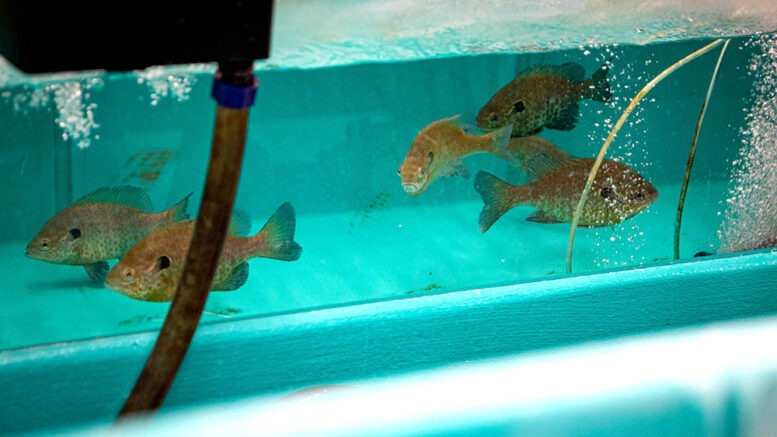By BSU Marketing and Communications—
MUNCIE, IN – A recent study conducted by researchers at Ball State University, in partnership with Fishbrain, the world’s most popular fishing app, offers new insight into “invasion superhighways,” in which aquatic invasive species are spreading across the U.S.
Using data from the Fishbrain app, which has more than 14 million registered users worldwide, researchers from Ball State’s College of Sciences and Humanities have revealed a network of human movements that form these invasion superhighways. Ultimately, the research underscores not only the potential of expansive data sources such as Fishbrain, but also the important role that anglers can play in preventing aquatic invasive species from spreading further.
“This research allows us to understand how invasive species are spreading in the U.S. in unprecedented ways, which represents a huge step in conservation efforts,” said Dr. Paul Venturelli, associate professor of Fisheries at Ball State and director of the PhD in Environmental Sciences program. “Technology is giving us the tools to help conserve bodies of water across the U.S., so we must use it effectively if we are to protect aquatic life.”
Ball State researchers involved in the study, linked here, include Dr. Venturelli; Jessica Weir, a PhD candidate in Ball State’s Environmental Sciences program; Dr. Jay Bagga, professor of Computer Science; and Dr. Adam Berland, associate professor of Geography.
Data and the future of conservation
One of the key tools in the fight to conserve aquatic life across the U.S. is data. Historically, it has been difficult to gather data on the movement of invasive species, especially when this spans large areas and different jurisdictions. However, tech and data are now providing a solution to this issue.
By partnering with Fishbrain, researchers at Ball State could use data logged by millions of anglers over the last decade to follow the movements of aquatic invasive species and how they correlate with the movements of anglers. This provides an unprecedented understanding of the “superhighways” of angler movement that invasive species travel along.
Tech platforms can serve as educational tools that advocate for responsible fishing practices, helping lead to action and preventing acceleration of the transmission of aquatic invasive species. The continued cooperation of tech platforms to protect aquatic life will be a key tool in tackling invasive species.
“Collaboration with tech platforms like Fishbrain can offer the data to help us understand the spread of invasive species, but this data can also be used to determine the need for interjurisdictional collaboration,” Dr. Venturelli said. “Our research shows that invasive species are moving across counties and states, so the effort to combat the spread of these species must be similarly expansive. The new knowledge gained in this research will also enable anglers to help protect the waters they fish in by adopting sustainable angling habits.”
Important role of anglers
Ball State’s research indicates that anglers can be part of the solution to the spread of invasive species by taking simple steps to adapt their habits. This can include avoiding fishing in different waters in the same seven-day period, which can help to prevent the spread of invasive species across different waters. Cleaning angling equipment between uses is another useful step.
In the future, researchers anticipate seeing more data about which waters are the largest hubs for invasive species, so that anglers know where to be most mindful, and ensure their angling practices reflect this necessity.
Ball State researchers found that smartphone apps can effectively collect data that is integral to research, and that these tools also help to encourage public engagement. Anglers, as well as other groups visiting waterways for recreation, can play a significant role both in contributing to data collection and in preventing possible invasions—by becoming part of the solution.
“We at Fishbrain are delighted that our data illuminating angler behavior, fishing patterns, and fishing trends has been able to support this important project,” said Johan Attby, CEO at Fishbrain. “Anglers can play a vital role in looking after the environment, so it is great that by sharing data on angler movements, researchers are better able to understand potential risks. We hope that by sharing the outcomes of this research, our users will feel encouraged to educate themselves about aquatic invasive species and how they can help to prevent their spread.”
About Ball State
Founded in 1918 and located in Muncie, Ball State University is one of Indiana’s premier universities and an economic driver for the state. Ball State’s 21,600 students come from all over Indiana, the nation, and the world. The 790-acre campus is large enough to accommodate first-rate facilities and 19 NCAA Division I sports, but our welcoming and inclusive campus is small enough to ensure the friendliness, personal attention, and access that are the hallmarks of the University. Destination 2040: Our Flight Path establishes Ball State’s ambitious goals for our second century. We Fly!
About Fishbrain
Fishbrain is the world’s most popular mobile app, social network, and social commerce platform for people who love fishing. With over 14 million registered users across the globe, the free-to-use app helps create the best possible fishing experience by providing everyone – whether beginner or pro – with the tools, insights, support, and fishing gear to fully enjoy the world’s most popular hobby. The app’s interactive map helps anglers find new fishing spots and see what other people are catching, with what bait and specifically where.
Fishbrain is committed to responsible fishing practices, encouraging a catch and release policy where appropriate, and working with Return ‘Em Right to prevent barotrauma in fish. Furthermore, Fishbrain’s acquisition of Fish Rules encourages anglers to stay up to date with local regulations. Fishbrain also works with federal fishery agencies to distribute information about fishing regulations to promote sustainable fishing habits amongst anglers. This takes place alongside Fishbrain’s work with organisations such as The Billfish Centre and Invasive Species Centre to conserve aquatic environments for the future.



